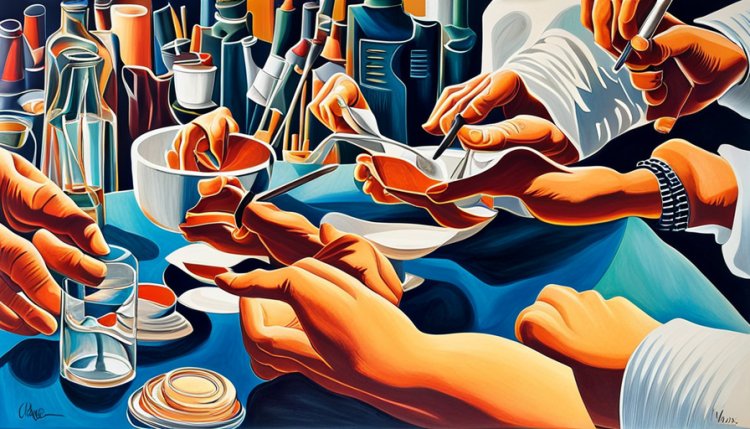Bengaluru: Quite fittingly, the sprawling National Gallery of Modern Art (NGMA) in Bengaluru is paying tribute to one of India's legendary master printmakers, 79-year-old Devraj Dakoji. A retrospective that showcases over 600 of this prolific artist's works (which he says he whittled down from 3,000-plus) also highlights a unique problem that India faces Dakoji is its last 'Master Printmaker'.
The curating team of the exhibition, which is on till October 10, has traced printmaking in India to when the Portuguese brought the printing press to Goa. One of its earliest highs was when Ravi Varma's popular paintings were printed as oleographs.
According to curators, post 1990s, digital technology led to its significant transformation. In recent years, artists like Jyoti Bhatt, Nataraj Sharma, Ravikumar Kashi, Gulam Mohammed Sheikh, Ranbir Kaleka, Baiju Parthan, Pushpamala N, Akbar Padamsee, Rameshwar Broota and Gogi Saroj Pal, to name a few, created interesting visual vocabulary through experiments.
But the problem in India is that printmaking artists mainly print their own work, says Pratibha, who is also a celebrated printmaker and Dakoji's wife. Also, the boom in the art market post globalisation hardly trickled down to printmaking, as prints were considered not good enough for investing in, Pratibha adds.
Despite these shortcomings, Dakoji says he became more determined to become a Master Printer -- a title he spent time and effort acquiring. A bold choice for someone who could have easily made more money from paintings. His technique of using intricate pen and ink criss-crosses to create light and forms on canvases, as well as his washed-out watercolours seascapes of Vizag in Andhra Pradesh and landscapes of Nepal and the Indian Himalayas -- both on display at the retrospective, are a testimony to his meticulous skills in this regard.
It is hard to explain why I liked printmaking more. All I knew was that I wanted in-depth knowledge of printmaking. I was in awe of Japanese and Chinese techniques.
To become a Master Printer though, one had no other option but to leave India. Even for his specialisation in printmaking earlier, he had to go to Britain. He completed his postgraduation in printmaking from Chelsea School of Art in London in 1976.
So, in 1992, when fellow artists were experimenting in a small way with lithographs and linocuts, Dakoji took off to Albuquerque, to the Tamarind Institute in University of New Mexico, to immerse himself in them.
Initially, I was homesick and hostile. I felt I was wasting my time doing things I already know. But soon I realised that in India I had never really learnt printmaking as the science it is, leave alone professionalism. For instance, if you are printing a large addition of prints, you really have to write down all the chemical equations so that the same colours can be reproduced in all prints, he says.
And it was there, he says, that he also learnt the importance of collaborating with other artists. I realised that working with others is an equally creative and demanding process. It is stimulating in a very different kind of way, adds Dakoji.
As part of its outreach programme, NGMA had also organised a special talk on collaborative printmaking on September 22. According to NGMA Deputy Curator Darshan Kumar Y U, this was in part to nudge art students towards the way forward when it comes to printmaking collaborations with other artists.
Nazneen Banu, director of Bengaluru NGMA, says the exhibition was also an attempt to mainstream the conversation around collaborative printmaking. We need to reassess the practice as it stands today, she insists.
In her talk, Essye Klempner from EFA Robert Blackburn Printmaking Workshop in New York, where Dakoji continues to unravel nuances of printmaking as master, pointed out how even her prestigious institution had often come close to shutting shop.
Blackburn had to literally go out there and push other artists to try printmaking, says Klempner. That is how the oldest community workshop in the United States could remain the longest running one too.
In the discussion that followed the talk, Dakoji and Pratibha explained how their attempt to start a printmaking workshop in India ended in failure, as artists in India were yet to warm up to the idea of collaborative art. They set up Atelier 2221, a pioneering collaborative venture in Shahpur Jat, New Delhi in 1996. It was later closed in 2003.
Even now, I am more than willing to help share the knowledge that I have acquired over the years in India. But every time I make an attempt, I feel like I am hitting my head against the wall. The first step should be creating awareness about the extraordinary results that can be achieved through collaborations, says Dakoji.
To prove his point, he walks you through the works of the artists who had collaborated with him, either through Atelier 2221 or Robert Blackburn workshop, also on display at NGMA.
The most popular of his collaborations was with M F Husain. He had come to Blackburn studio in 1994, to make his lithographs more colourful. He only knew to do that using many plates, which is a very laborious process. So, he came to the studio expecting us to do the work. But I told him that is not how it is done and told him about a Chinese technique, Chine Colle, which uses coloured tissue papers to get that many-coloured effect without multiple plates.
Dakoji says Husain was so excited about the technique that he bought bundles of colour tissues and did 12 images in 25 editions in his first attempt. Later, when he came again in 2008, Dakoji said he wanted to experiment more with Chine Colle. He wanted to, for instance, overlap colour tissues to get new colours. We ended up breaking many printmaking rules and created a new kind of work, says Dakoji.



